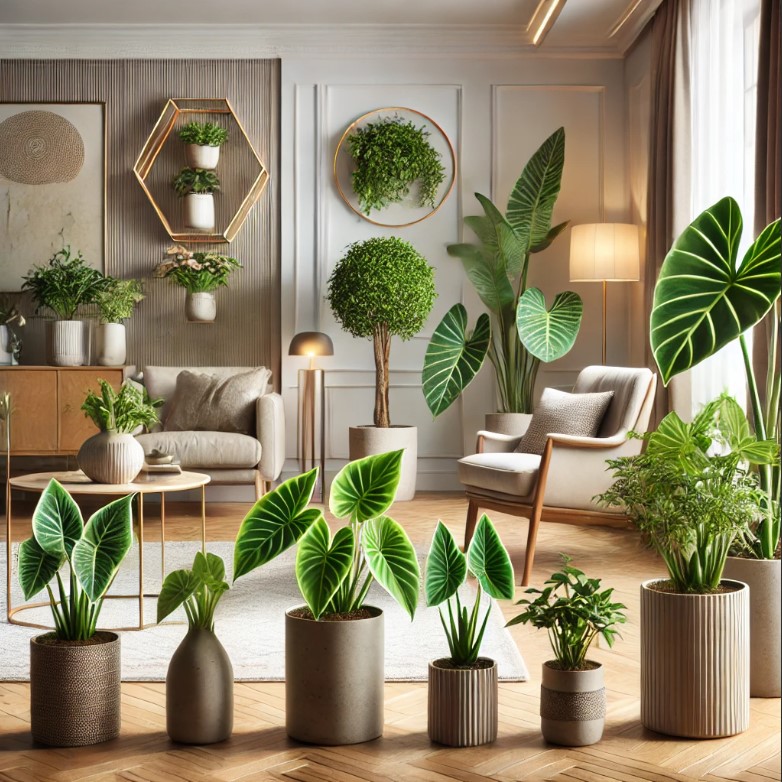
Alocasia plants are commonly called elephant ear plants, prized for their amazing foliage and low-care nature making them a perfect houseplant or indoor gardening choice – and they pair great with other easy-to-grow houseplants (with bright indirect light!). But to really get the most from your Alocasia, you need to know what each variety needs in terms of care. Be it the commercially popular Alocasia Polly, the dramatic Alocasia Frydek or the stately Alocasia Regal Shield, these amazing house plants will all do well for you with the right care when in your home.
Growing Conditions Alocasia can be fussy about light, temperature, humidity and soil. Knowing these factors is important for lush, healthy plants. This will include common care practices across different varieties, what to do when your Alocasia gets leggy and where to find light for any of these types, watering techniques (so your Alocasia is neither over-watered nor under-watered) as well as suitable soil mixes. With these tips to guide you, your Alocasia plants should thrive and continue to make an impressive showing for years!
1. All Aglonema Plant Types Explained: 2
There are many Alocasia varieties with their own features. Different types of Popular varieties include Alocasia Polly, Alocasia Frydek and Alocasia Zebrina, each has certain requirements for light, soil and humidity. It is important to learn about these types before choosing the best one for you in your home.
2. Alocasia Lighting Needs
Alocasia need a lot of bright indirect light, but keep them away from direct sunlight. Too much sun exposure will burn their leaves while too little light will not allow them to grow. Be sure to put your Alocasia by a window with filtered sunlight!
3. What type of soil is best for Alocasia?
Alocasia plants do particularly well in a very high organic soil that drains easily. Any tropical plant mix is suitable as it provides ideal moisture retainage without waterlogging.
4. Watering Your Alocasia
Although Alocasia plants prefer a moist growing environment, they do not like sitting in water. Alocasia — Water your Alocasia regularly, allowing the top inch of soil to dry out between waterings. Do not allow the plant to set in water since this can expose it to root rot.
5. Indoor Temperature and Humidity Needs
Ideal and Suitable Temperatures The ideal temperature for Alocasia plants will be 65°F to 80°F (18°C to 27°C). They also require high humidity for proper growth. In low humidity environments, consider a humidity tray or ideally, room humidifier to keep air moist.
6. Fertilizing Alocasia Plants
During the growing season (spring and summer) you should be able to give your Alocasia a balanced liquid fertilizer. While flowering, reduce the feeding during its dormant time in the autumn and winter months.
7. Pruning and Cleaning
Keep your Alocasia up to par by pruning it regularly of dead or damp leaves. Wipe the leaves with a damp cloth to remove dust and promote photosynthesis.
8. Repotting Alocasia
Alocasia Plants require potting every 1-2 years for growth. Select a new container that is 1-2 inches wider than the one you have and make sure it has drainage holes.
9. Coping Up with Typical Alocasia Pests
Although Alocasia are not prone to pests, you may still find spider mites, aphids, or mealybugs on them from time to time. Check your plants frequently for pests and attack infestations early with insecticidal soap or neem oil.
10. Signs of Overwatering
However, Alocasias are prone to overwatering. Yellowing or brown edges on the leaves may indicate overwatering. Adjust your watering habits and ensure proper drainage.
11. How to Propagate Alocasia
Methods of propagation is through offsets or stem cuttings. For propagation, just snip the offset or cutting leave and transplant them into another pot with well-draining soil.
12. Alocasia Toxicity
Note that Alocasia is toxic to pets and people when consumed. Avoid at all cost around pets and little kids so they do not have any health issues.
13. Alocasia Growth Cycle
Alocasia is quite fast grower but most of them grow quickly only in their growing periods which happen during spring, summer, fall then slowly in the winter. Your Alocasia should put forth new leaves often during the growing season.
14. Picking the Best Alocasia for Your Home
When choosing the best Alocasia inside your house, you must keep in mind the amount of light condition, humidity, and size of your space. Certain varieties such as Alocasia Polly are ideal in small spaces, other types like Alocasia Gigantea need plenty of space to expand.
15. Tips for Fixing Alocasia Problems
Examine your Alocasia for any pest or disease issues, and ensure that watering practices are not excessive or insufficient. If you add too many nutrients — especially nitrogen — you can end up with big beautiful green leaves and no blooms, so adapt your care routine accordingly to ensure the plant receives proper light, water and nourishment.
With an appreciation for the particular preferences of Alocasia and adherence to a few guidelines, you can have healthy plants with their colorful foliage in your home long into the future. With proper care, your Alocasia will be happy and thrive in any room.






